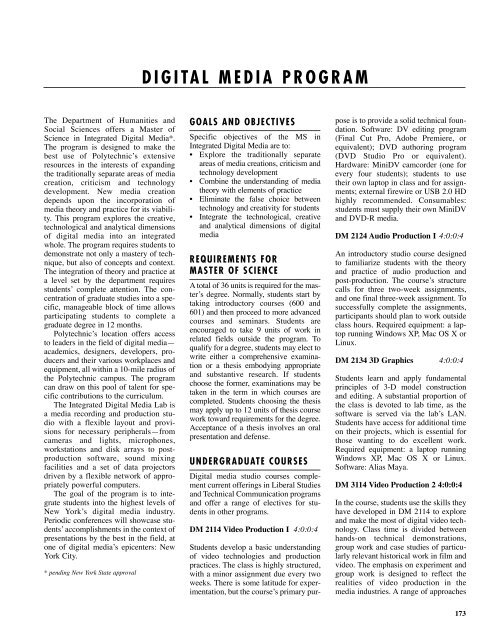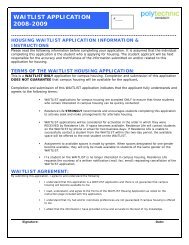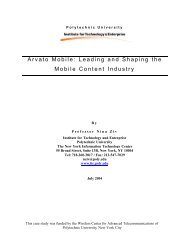POLYTECHNIC UNIVERSITY 2005-2007
POLYTECHNIC UNIVERSITY 2005-2007
POLYTECHNIC UNIVERSITY 2005-2007
Create successful ePaper yourself
Turn your PDF publications into a flip-book with our unique Google optimized e-Paper software.
DIGITAL MEDIA PROGRAM<br />
The Department of Humanities and<br />
Social Sciences offers a Master of<br />
Science in Integrated Digital Media*.<br />
The program is designed to make the<br />
best use of Polytechnic’s extensive<br />
resources in the interests of expanding<br />
the traditionally separate areas of media<br />
creation, criticism and technology<br />
development. New media creation<br />
depends upon the incorporation of<br />
media theory and practice for its viability.<br />
This program explores the creative,<br />
technological and analytical dimensions<br />
of digital media into an integrated<br />
whole. The program requires students to<br />
demonstrate not only a mastery of technique,<br />
but also of concepts and context.<br />
The integration of theory and practice at<br />
a level set by the department requires<br />
students’ complete attention. The concentration<br />
of graduate studies into a specific,<br />
manageable block of time allows<br />
participating students to complete a<br />
graduate degree in 12 months.<br />
Polytechnic’s location offers access<br />
to leaders in the field of digital media—<br />
academics, designers, developers, producers<br />
and their various workplaces and<br />
equipment, all within a 10-mile radius of<br />
the Polytechnic campus. The program<br />
can draw on this pool of talent for specific<br />
contributions to the curriculum.<br />
The Integrated Digital Media Lab is<br />
a media recording and production studio<br />
with a flexible layout and provisions<br />
for necessary peripherals—from<br />
cameras and lights, microphones,<br />
workstations and disk arrays to postproduction<br />
software, sound mixing<br />
facilities and a set of data projectors<br />
driven by a flexible network of appropriately<br />
powerful computers.<br />
The goal of the program is to integrate<br />
students into the highest levels of<br />
New York’s digital media industry.<br />
Periodic conferences will showcase students’<br />
accomplishments in the context of<br />
presentations by the best in the field, at<br />
one of digital media’s epicenters: New<br />
York City.<br />
* pending New York State approval<br />
GOALS AND OBJECTIVES<br />
Specific objectives of the MS in<br />
Integrated Digital Media are to:<br />
• Explore the traditionally separate<br />
areas of media creations, criticism and<br />
technology development<br />
• Combine the understanding of media<br />
theory with elements of practice<br />
• Eliminate the false choice between<br />
technology and creativity for students<br />
• Integrate the technological, creative<br />
and analytical dimensions of digital<br />
media<br />
REQUIREMENTS FOR<br />
MASTER OF SCIENCE<br />
A total of 36 units is required for the master’s<br />
degree. Normally, students start by<br />
taking introductory courses (600 and<br />
601) and then proceed to more advanced<br />
courses and seminars. Students are<br />
encouraged to take 9 units of work in<br />
related fields outside the program. To<br />
qualify for a degree, students may elect to<br />
write either a comprehensive examination<br />
or a thesis embodying appropriate<br />
and substantive research. If students<br />
choose the former, examinations may be<br />
taken in the term in which courses are<br />
completed. Students choosing the thesis<br />
may apply up to 12 units of thesis course<br />
work toward requirements for the degree.<br />
Acceptance of a thesis involves an oral<br />
presentation and defense.<br />
UNDERGRADUATE COURSES<br />
Digital media studio courses complement<br />
current offerings in Liberal Studies<br />
and Technical Communication programs<br />
and offer a range of electives for students<br />
in other programs.<br />
DM 2114 Video Production I 4:0:0:4<br />
Students develop a basic understanding<br />
of video technologies and production<br />
practices. The class is highly structured,<br />
with a minor assignment due every two<br />
weeks. There is some latitude for experimentation,<br />
but the course’s primary purpose<br />
is to provide a solid technical foundation.<br />
Software: DV editing program<br />
(Final Cut Pro, Adobe Premiere, or<br />
equivalent); DVD authoring program<br />
(DVD Studio Pro or equivalent).<br />
Hardware: MiniDV camcorder (one for<br />
every four students); students to use<br />
their own laptop in class and for assignments;<br />
external firewire or USB 2.0 HD<br />
highly recommended. Consumables:<br />
students must supply their own MiniDV<br />
and DVD-R media.<br />
DM 2124 Audio Production I 4:0:0:4<br />
An introductory studio course designed<br />
to familiarize students with the theory<br />
and practice of audio production and<br />
post-production. The course’s structure<br />
calls for three two-week assignments,<br />
and one final three-week assignment. To<br />
successfully complete the assignments,<br />
participants should plan to work outside<br />
class hours. Required equipment: a laptop<br />
running Windows XP, Mac OS X or<br />
Linux.<br />
DM 2134 3D Graphics 4:0:0:4<br />
Students learn and apply fundamental<br />
principles of 3-D model construction<br />
and editing. A substantial proportion of<br />
the class is devoted to lab time, as the<br />
software is served via the lab’s LAN.<br />
Students have access for additional time<br />
on their projects, which is essential for<br />
those wanting to do excellent work.<br />
Required equipment: a laptop running<br />
Windows XP, Mac OS X or Linux.<br />
Software: Alias Maya.<br />
DM 3114 Video Production 2 4:0:0:4<br />
In the course, students use the skills they<br />
have developed in DM 2114 to explore<br />
and make the most of digital video technology.<br />
Class time is divided between<br />
hands-on technical demonstrations,<br />
group work and case studies of particularly<br />
relevant historical work in film and<br />
video. The emphasis on experiment and<br />
group work is designed to reflect the<br />
realities of video production in the<br />
media industries. A range of approaches<br />
173




